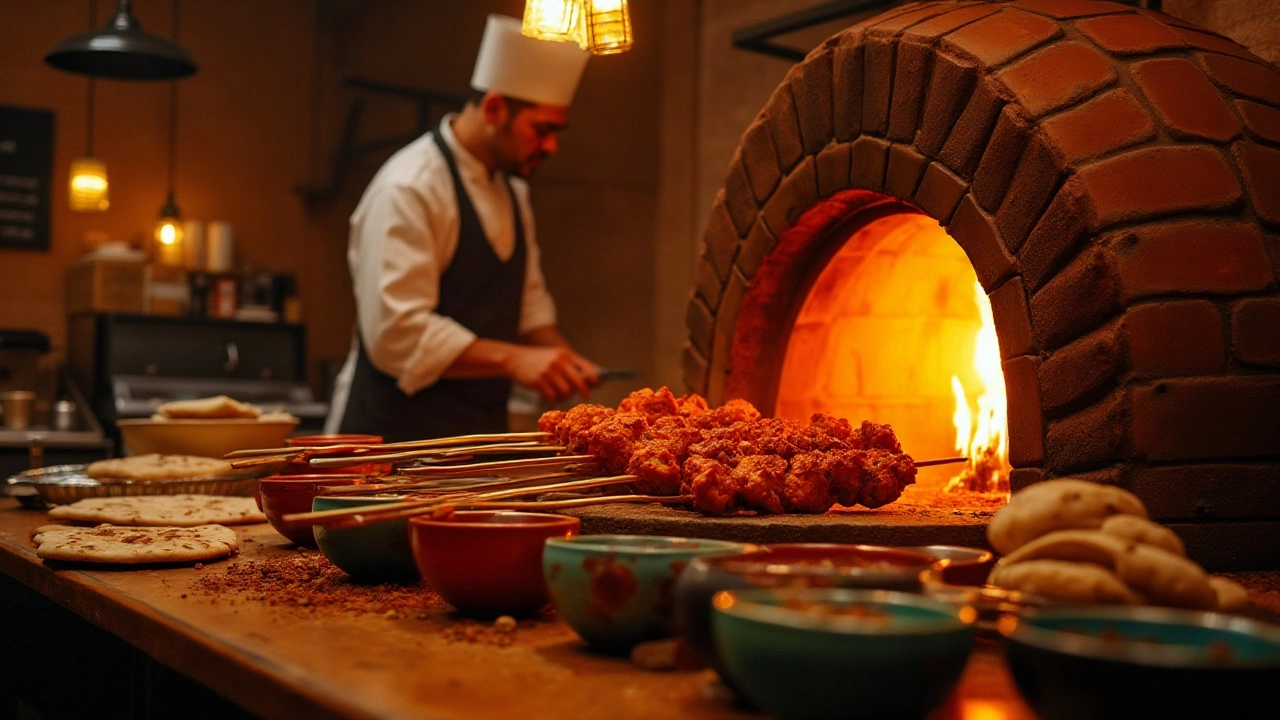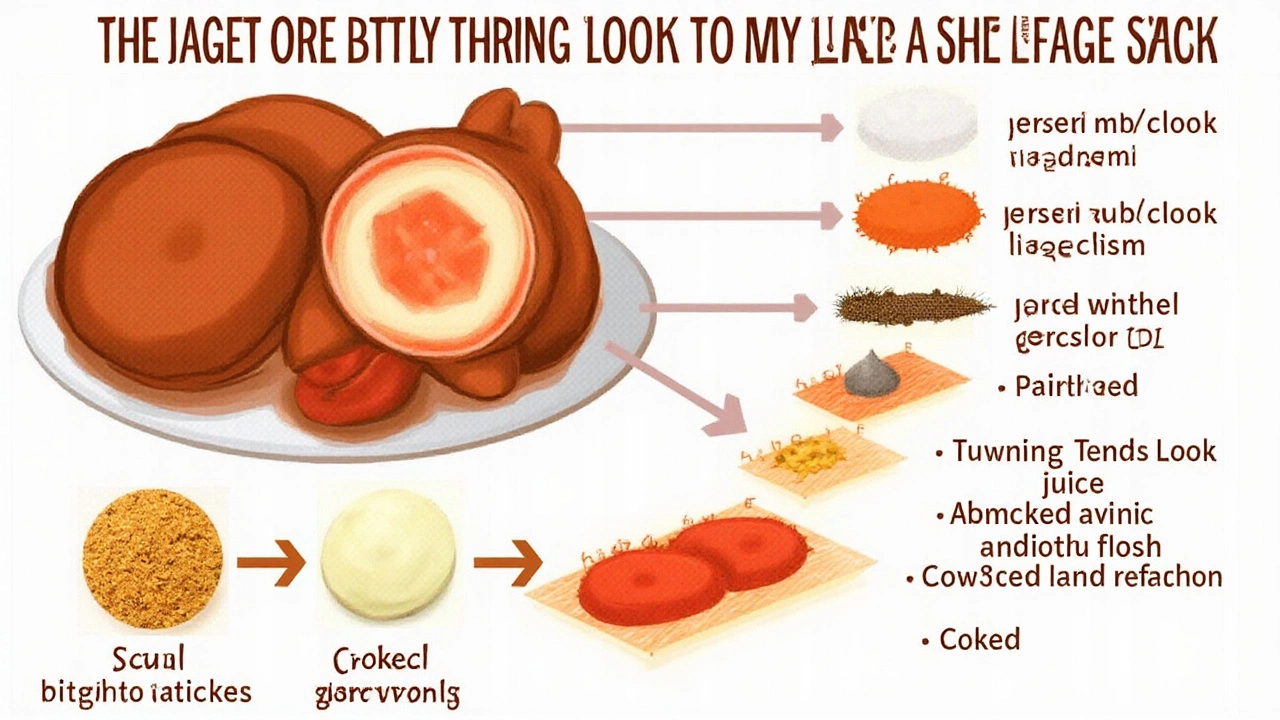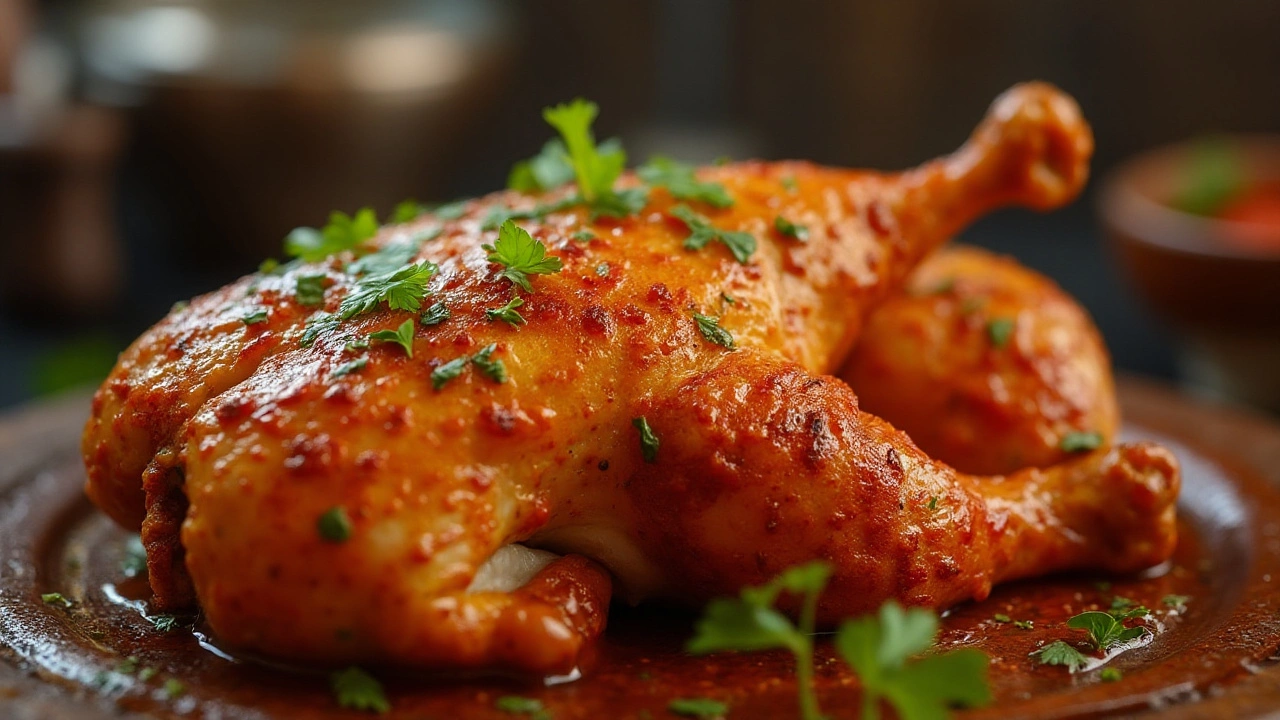14 Dec 2024
- 0 Comments
You cut into a perfectly cooked piece of tandoori chicken and spot red liquid seeping out. Panic sets in—is it undercooked? Relax, because what you're seeing is typically not blood. Despite appearances, it's actually a combination of water and protein, known technically as myoglobin, that imparts a reddish hue when mixed with the outer spices. Understanding this can pave the way to mastering this delicious dish.
While it's tempting to conjure images of undercooked meat, this red liquid is actually quite normal, especially in chicken dishes prepared with bold, rich spices like tandoori. Our culinary exploration will demystify what's in your dish, bust some common misconceptions, and help you enhance your cooking skills. With insights into preparation and tips on achieving the perfect cooking temperature, you'll bring out the best of flavors and textures without overcooking or worrying unnecessarily.
- Understanding the Red Liquid
- Exploring Common Myths
- Scientific Explanation
- Enhancing Your Tandoori Chicken Cooking
- Tips for Perfect Juicy Chicken
- Addressing Safety Concerns
Understanding the Red Liquid
At first glance, when you slice into a beautifully cooked, spiced piece of tandoori chicken, the sight of red liquid can cause unexpected alarm. But rest assured, this liquid isn't what most people assume it to be. It's not blood, and it’s certainly not a sign that your dish is undercooked. This common occurrence, particularly in chicken dishes, is actually made up of a protein called myoglobin. Myoglobin is present in the muscle tissues of animals and is responsible for transporting oxygen within the cells. When exposed to heat, myoglobin changes color, giving cooked chicken that signature pinkish-red hue often mistaken as undercooked meat.
One of the reasons for this confusion is due to a common misconception propagated by visuals and recipes seen over time. Chicken, in particular, can present this deceptive red liquid due to myoglobin, which should not be mistaken with blood. Blood is mostly removed during the chicken processing before distribution. As you cook the chicken, especially in moist heat methods or with marinates like those used in making tandoori chicken, these myoglobin proteins might not fully denature, leaving a pinkish tinge that's a perfectly normal part of the process.
The Role of Marinade and Cooking Methods
The process of marinating and the choice of cooking methods play a significant role in the appearance of the chicken when you finally take it out of the oven. In tandoori chicken, the distinctive red hue is appealingly due to spices like red chili powder or food coloring. However, the redness of the liquid that sometimes trickles out isn't about those spices vividly staining the inner parts. Instead, it's a dance between moisture content preserved by the marinade and the heat-induced changes in myoglobin. An important tip to avoid confusion is using a meat thermometer; chicken is typically safe to eat at an internal temperature of around 74°C (165°F). This ensures the myoglobin inside the chicken has reached the point where bacterial risks are minimized, but color alone should not be the determinative factor of doneness.
Understanding these basics can make your cooking more enjoyable and adventurous, especially when you take courage in experimenting with recipes. As James Beard once said,
"Good bread is the most fundamentally satisfying of all foods; and good bread with fresh butter, the greatest of feasts."Likewise, understanding the science behind what we observe cuts through misconceptions and elevates our culinary experiences.
Exploring Common Myths
Whenever you see red liquid resembling blood in your tandoori chicken, the immediate reaction might be concern, especially thinking the meat might be undercooked. Yet, this notion stems from a very common myth that's spread among cooks and food enthusiasts alike. The truth is, this red liquid is not blood. After slaughter, chicken is thoroughly bled out, rendering the fear of blood no more than a fallacy. What remains in the muscle fibers is a protein called myoglobin, which tints the juices red when the meat is cooked to a specific temperature. Much of the confusion often comes from expecting chicken to appear completely white, ignoring its natural pigmentation facilitated by myoglobin.
There's also a rather persistent myth that chicken should be cooked until it reaches a certain color, usually an assumed bright white interior. This generalized rule doesn’t consider the myriad of cultural influences and recipes like tandoori, where the spice blends and marination can alter the meat’s color even when it’s safely cooked. As with many cooking myths, this is best tackled with culinary knowledge and a trusty meat thermometer, ensuring the chicken reaches a safe internal temperature of 75°C (165°F). This is recognized as a reliable measure for safety by kitchen pros and verified by agencies like the USDA.
Another widespread myth is linking the presence of the red liquid with the freshness of the chicken. While it’s easy to jump to such conclusions, the liquid’s color has little to do with how fresh your chicken is. Instead, it's a function of cooking techniques, especially when dealing with whole chicken cuts or bone-in pieces. Certain parts near the bones might retain more of the myoglobin due to their structural density. In reality, this myth originates from a period when refrigeration wasn't as widespread, leading to misconceptions about how chicken's internal colors dictated its edibility.
"Cooking creates chemical changes in foods that alter their color. These changes are perfectly natural and create a richer flavor and aroma." - The Science of Cooking, Dr. Francis Wu
It’s crucial to dispel these myths because they can lead to overcooking, which needlessly affects the juicy texture of dishes like tandoori chicken. By applying the true facts, any home cook can confidently prepare perfectly cooked, flavorful chicken without second-guessing based on misleading color cues. The vibrant red hues often highlight a well-prepared marinade flowing into the delicate fibers, blending flavors that excite the taste buds. Embrace the science and delve into the heritage that our food offers, rather than succumbing to amusing myths that have overstayed their welcome.

Scientific Explanation
When you observe that red liquid oozing from your perfectly cooked tandoori chicken, what you're actually seeing is not blood, but a protein solution known as myoglobin. Myoglobin, similar to hemoglobin, is found in muscle tissue and is responsible for storing oxygen in muscle cells, which is vital for physical activity and metabolism. Unlike hemoglobin, it remains in the tissues and does not circulate in the blood. Its reddish tone often leads to the misconception that the chicken is undercooked or bloody, but rest assured, this is a normal occurrence in well-prepared poultry dishes.
Many people presume that chicken should always have a white, even color when fully cooked. However, the color of chicken meat can vary due to several factors including the age of the bird, its diet, and even the cooking method used. It’s important to recognize that the red liquid is not indicative of poor cooking, but rather a safe and natural phenomenon caused by heat-induced changes to the proteins in the meat. When chicken is prepared with intense spices, like in the case of tandoori chicken, the color may appear more pronounced. Myoglobin's primary function in a living muscle is to bind oxygen molecules and store them, ensuring a steady supply when oxygen levels drop during exertion.
During the cooking process, temperatures rise and proteins, including myoglobin, undergo structural changes. These changes result in a transformation in texture and color. In fact, myoglobin tends to turn brown as temperatures exceed roughly 80 degrees Celsius (around 175 degrees Fahrenheit), but depending on the quantity and mixture of spices, some redness can persist, contributing to the succulent aesthetic of the dish. To dismiss any concerns about undercooked chicken, simply use a meat thermometer and ensure the internal temperature reaches a safe 74 degrees Celsius (165 degrees Fahrenheit).
According to food safety expert Harold McGee, "The pink sometimes seen in chicken... is just a chemical reaction between the meat's iron pigments and the hemoglobin left in its marrow or in the surrounding tissues." This understanding elevates our appreciation of cooking as both an art and a science.
Another interesting aspect of cooking tandoori chicken is the impact of temperature and cooking time on myoglobin. Lower cooking temperatures typically preserve more of the myoglobin's color, while higher temperatures break it down faster. The traditional methods of cooking tandoori involve a hot, open-flame oven, which enhances the breakdown of myoglobin and imparts a well-cooked texture while retaining its natural red hue from the spices. Using this knowledge can help cooks to fine-tune their methods, preserving the dish's authenticity while ensuring thorough cooking.
Conclusion
Understanding the science behind the red liquid in chicken not only dispels culinary myths but also enhances our knowledge as home chefs. It's a testament to how a deep understanding of food can transform simple cooking into a skillful practice.
Enhancing Your Tandoori Chicken Cooking
Mastering the art of making tandoori chicken is like composing a symphony – each element adds its own flavor that harmonizes into an unforgettable experience. To improve your tandoori chicken cooking skills, start with the basics: a well-seasoned marinade. The secret to a flavorful marinade lies in its complexity, combining yogurt, lemon juice, and spices like cumin, coriander, and turmeric. Letting your chicken sit in this concoction overnight is a surefire way to enhance its flavor. The acid in the lemon and the yogurt's probiotics work wonders in tenderizing the meat, ensuring that the result is juicy and bursting with flavor.
Another critical factor in perfecting your tandoori chicken is the cooking technique. Traditionally, this dish is cooked in a tandoor, a type of cylindrical clay oven, but don't worry if you don't have one at home. Using your grill or an oven on high heat works just as well. Preheat your oven to around 250°C, which mimics the intense heat of a tandoor, and use a rack to elevate the chicken. This setup ensures the heat circulates around the chicken, cooking it evenly and locking in those lovely juices. According to culinary expert Madhur Jaffrey, “The flavor of tandoori chicken cooked properly becomes a thing of magic.”
For maximum flavor infusion, periodically baste your chicken with melted butter or ghee during cooking. This step not only enhances the rich flavors but also adds a beautiful golden hue to the exterior. Some chefs recommend using a mix of oil and butter for basting to achieve a perfect balance between flavor and moisture. When your chicken reaches an internal temperature of 75°C, it's safe to eat, while still preserving its moist texture. With practice, you’ll learn to trust your instincts too; trust those senses as much as the thermometer.
Presentation plays a key role in elevating a dish from good to great. Garnishing with freshly chopped coriander, slices of onion, and wedges of lime offers a visual appeal and adds complimentary flavors. As a final touch, consider a sprinkle of fresh chaat masala right before serving; this sharpens and contrasts the complex background flavors of the marinade, offering a perfect finish to your work of art. Don't be afraid to experiment with spice levels and accompaniments – after all, creativity is often at the heart of cooking.
Here’s a quick checklist to guide you through the process of cooking tandoori chicken:
- Start with a flavorful marinade.
- Let your chicken marinate for at least 8 hours in the fridge.
- Use a rack to elevate your chicken while cooking.
- Baste your chicken regularly for additional flavor.
- Decorate with coriander and lime wedges for garnishing.
Remember, perfection doesn't happen overnight. Keep practicing, and in time, you'll have people raving about the most delightful tandoori chicken they've ever tasted!

Tips for Perfect Juicy Chicken
Achieving perfectly juicy chicken, especially when preparing your favorite tandoori chicken recipe, may feel like a culinary challenge, but with a few practical techniques, you can master it effortlessly. The key to juicy chicken lies in understanding the behavior of the meat and adjusting your cooking methods accordingly. One of the most well-known techniques involves brining the chicken beforehand. A basic saltwater brine not only seasons the chicken from within but also helps it retain moisture during the cooking process. Adding spices like turmeric or cayenne to the brine can infuse the chicken with an extra layer of flavor even before marination.
Another powerful method is marination. A marinade rich in yogurt, lemon juice, and spices is like a magic potion for your chicken. The acidity from the lemon and the enzymes in the yogurt work together to tenderize the meat, making it supple and ready for the tandoor or oven. Allowing the chicken to marinate for at least two hours, or ideally overnight, can make a significant difference. This is not just a passing note from home chefs; experts, too, like David Chang, a renowned restaurateur, emphasize the merit of properly marinating meat. As he puts it,
"Marinades are your ticket to deeper flavors in less time."
When it's time to cook, the temperature you choose can make or break the outcome. Cooking chicken at a high heat quickly sears the exterior, locking in the juices, which is desired especially for tandoori chicken. Preheat your oven to about 200°C for the perfect balance of cooking speed and texture. You should aim for an internal chicken temperature of around 75°C, which is recommended for safe consumption without losing juiciness. Some cooks rely on a meat thermometer to ensure this precision. Proper resting is crucial; once it’s out of the oven or grill, let it sit for a few minutes before serving, so the juices redistribute back into the meat fibers.
Let’s talk about basting—every cook's secret weapon. As the chicken cooks, brushing it periodically with oil or ghee keeps it moist and adds to the flavor profile. For tandoori, consider using melted ghee infused with garam masala. You can also add layers of flavor by throwing in whole spices like mace or cloves as the chicken roasts. What can elevate a dish even more is a final sprinkle of chaat masala before serving, offering a tangy finish to your creation.
Lastly, don't underestimate the power of choosing the right cut. Pieces with bones, like thighs or drumsticks, naturally retain more moisture compared to breasts. The bone acts as a conductor of heat, allowing the meat to cook more slowly and evenly, reducing the chances of drying out. The dark meat cuts are forgiving and will lend themselves better to retaining that desirable juicy texture. Many chefs agree that while breasts are popular, they can be tricky without these precautions.
In pursuit of culinary perfection, employing these thoughtful steps can turn your tandoori chicken into a succulent masterpiece. Remember, culinary arts are a combination of science and a bit of intuition. Experiment and let your taste passions guide you. Whether you are cooking for a special occasion or a weekday dinner, practicing these tips will ensure that each piece of chicken is tender, juicy, and bursting with flavor.
Addressing Safety Concerns
Cooking chicken is an art that must be garnished with safety, especially when dealing with delicious dishes like tandoori chicken. The mere sight of the red liquid can spark doubts about whether the meat is safe to eat. This concern often stems from the fear of harmful bacteria such as Salmonella and Campylobacter that are known to inhabit poultry. Thus, ensuring that chicken is thoroughly cooked is crucial to preventing foodborne illnesses. But the presence of the red liquid, usually myoglobin, doesn’t always mean undercooked chicken. In reality, meat can be safe to eat even when the juices are tinted red by this protein.
Consistently using a meat thermometer rectifies many errors arising from visual cues alone. Experts suggest that the safest internal temperature for cooked chicken is 75°C (165°F), ensuring that all potential bacteria are eradicated. Checking temperatures internally rather than relying on surface appearance provides a more accurate gauge of safety. Rest assured, cooking chicken until it reaches the appropriate internal temperature keeps your dish both delectable and safe.
"A thermometer is the only way to guarantee that your chicken is cooked adequately instead of relying on color alone," says food safety expert Marion Nestle, highlighting the significance of using precise tools over instinct.
Elevating your safety game doesn’t stop at temperature monitoring. Handling raw chicken requires a hygiene protocol, from washing hands before and after handling the meat to preventing cross-contamination through proper surface cleaning and using separate cutting boards for poultry and other ingredients. Such practices might seem excessive, but these layers of safety are essential to maintain when enjoying a cooking feast.
Therefore, when you embark on preparing tandoori chicken, let your focus embrace verified safety measures rather than fretting over the natural, albeit striking, redness of the juices. Just remember, delicious does not have to mean dangerous!
